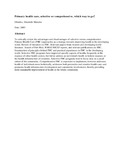| dc.contributor.author | Obimbo, Elizabeth Maleche | |
| dc.date.accessioned | 2013-07-23T06:09:23Z | |
| dc.date.available | 2013-07-23T06:09:23Z | |
| dc.date.issued | 2003 | |
| dc.identifier.citation | ELIZABETH, DROBIMBO. 2003. Primary health care, selective or comprehensive, which way to go? East Afr Med J . 2003 Jan; 80 ( 1 ): 7-10 . Review. PMID: 12755235 [PubMed - indexed for MEDLINE] Obimbo EM. East Afr Med J . 2003 Jan; 80 ( 1 ): 7-10 . Review. PMID: 12755235 [PubMed - indexed for MEDLINE]. : Kisipan, M.L. | en |
| dc.identifier.uri | http://erepository.uonbi.ac.ke:8080/xmlui/handle/123456789/49817 | |
| dc.identifier.uri | http://www.ncbi.nlm.nih.gov/pubmed/12755235 | |
| dc.description.abstract | To critically review the advantages and disadvantages of selective versus comprehensive Primary Health Care (PHC) approaches as a strategy towards improving health in the developing world. Review of literature on PHC. Relevant papers from western and developing world literature. Search of Pub-Med, WHO/UNICEF reports, and relevant publications on PHC. Examination of principles behind PHC and practical experiences in PHC in the developing world. Selective PHC programs have improved specific aspects of health, frequently at the expense of other health sectors, but fail to address an individual's health in holistic manner, or the health infrastructure of countries. Selective PHC programs tend to focus only on a small subset of the community. Comprehensive PHC is expensive to implement, however addresses health of individuals more holistically, addresses both preventive and curative health care, and promotes health infrastructure development and community involvement, thereby providing more sustainable improvement of health in the whole community. | en |
| dc.language.iso | en | en |
| dc.publisher | University of Nairobi | en |
| dc.title | Primary health care, selective or comprehensive, which way to go? | en |
| dc.type | Article | en |

